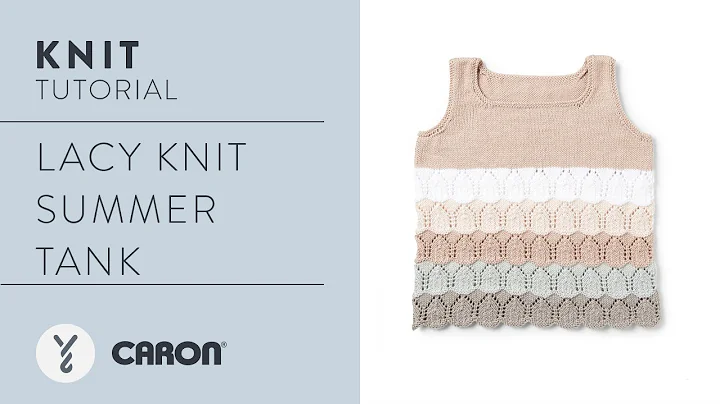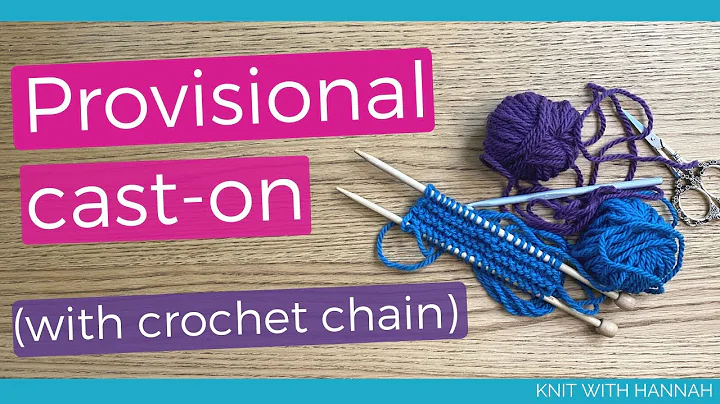Mastering the Provisional Cast On: Crochet CO with Lifeline
Table of Contents:
- Introduction
- What is a Crochet Cast On?
- Advantages of a Crochet Cast On
- Materials Needed for Crochet Cast On
- Step-by-Step Guide to Crochet Cast On
- Creating the Slipknot
- Casting On Stitches
- Working the First Row
- Releasing the Provisional Cast On
- Recapturing Stitches
- Knitting the Stitches
- Handling Stitch Mounting
- Pros and Cons of the Crochet Cast On
- Frequently Asked Questions
- Conclusion
Introduction
In the world of knitting, there are many techniques and cast on methods that a knitter can utilize. One such method is the crochet cast on. This versatile cast on technique allows you to create a temporary foundation row of stitches, which can later be recaptured and used in various ways. In this article, we will explore the crochet cast on in detail, discussing its advantages, step-by-step instructions, pros and cons, and more. So grab your knitting needles and crochet hook, and let's dive into the world of crochet cast on!
What is a Crochet Cast On?
A crochet cast on is a provisional cast on method that allows you to create a temporary row of stitches. This row can later be removed, revealing live stitches that can be utilized in various knitting techniques. Unlike other cast on methods, the crochet cast on provides flexibility and ease in managing your knitting projects. By using a crochet hook and your project yarn, you can easily create stitches that mimic the appearance of a knitted row.
Advantages of a Crochet Cast On
The crochet cast on offers several advantages over other provisional cast on methods. Firstly, it provides the option to use waste yarn or not. If your project yarn is smooth and light in color, you can skip the use of waste yarn. However, if your project yarn is dark, fuzzy, or textured, using waste yarn for the provisional cast on is recommended for better visibility and ease of knitting. Additionally, the crochet cast on is a technique that most knitters are already familiar with, making it accessible and easy to adapt for this purpose.
Materials Needed for Crochet Cast On
To perform the crochet cast on, you will need a few essential materials. These include:
- Project Needles: The needles you will be using for your knitting project.
- Crochet Hook: Choose a crochet hook that is similar in size to your project needles.
- Project Yarn: The yarn you will be using for your knitting project.
- Waste Yarn (optional): If your project yarn is dark, fuzzy, or textured, it is advisable to have some waste yarn to use for the provisional cast on.
- Locking Stitch Marker: Used to mark the double stitches when recapturing stitches.
Step-by-Step Guide to Crochet Cast On
Now that we have covered the basics, let's dive into the step-by-step process of performing the crochet cast on. It is crucial to follow each step carefully for a successful cast on.
Creating the Slipknot
To begin the crochet cast on, create a slipknot using your project yarn. Leave a sufficient tail for later use.
Casting On Stitches
The number of stitches you cast on will depend on your project requirements. To determine the number, cast on half of the desired stitches. For example, if you need 20 stitches, cast on 10 stitches. If you need an odd number of stitches, round up to the nearest even number.
Working the First Row
Using your crochet hook, create a few chain stitches after casting on. Enlarge the final loop and leave it dangling. Slide the stitches to the other end of the needle.
Releasing the Provisional Cast On
Attach a locking marker to double the stitches. Begin the first row with a yarn over if you have an odd number of cast on stitches. Alternate yarn over with knit one or purl one, depending on your pattern.
Recapturing Stitches
After working a few rounds or rows, you can release the crochet provisional cast on and create a lifeline for your project. Use your project needles or a smaller needle to recapture the stitches. Be mindful of the stitch mounting when recapturing.
Knitting the Stitches
Once you have recaptured the stitches, you can start knitting them as desired. Pay attention to the mounting of the stitches and adjust your knitting technique accordingly.
Handling Stitch Mounting
The recaptured live stitches may be mounted differently on the needle, requiring you to knit or purl them accordingly. You can either knit the stitches while pushing against the leading leg or remount the stitches before knitting them. Find the method that works best for you.
Pros and Cons of the Crochet Cast On
Like any knitting technique, the crochet cast on has its pros and cons. Let's take a closer look:
Pros:
- Provides flexibility in choosing to use waste yarn or not.
- Based on a familiar technique, making it easier to adapt.
- Allows for the recapture of stitches before removing the temporary cast on.
- Easy removal of the provisional cast on with a single tug.
- The number of recaptured stitches matches the original cast on number.
Cons:
- Requires attention to stitch mounting while knitting or purling recaptured stitches.
Conclusion
The crochet cast on is a versatile and useful technique for any knitter. Its ability to create a temporary row of stitches, which can later be recaptured and used in various knitting techniques, makes it an invaluable skill. By following the step-by-step guide provided in this article and considering the pros and cons, you are now ready to try out the crochet cast on in your knitting projects. Remember to practice and experiment with different methods to find what works best for you. Happy knitting!
FAQs
Q: Can I use the crochet cast on for any knitting project?
A: Yes, the crochet cast on can be used for various knitting projects, including scarves, shawls, sweaters, and more.
Q: Do I need to use waste yarn for the provisional cast on?
A: It depends on the characteristics of your project yarn. If it is smooth and light in color, you can skip using waste yarn. However, if it is dark, fuzzy, or textured, using waste yarn is recommended for better visibility and ease of knitting.
Q: How do I handle stitch mounting when recapturing stitches?
A: You can either knit the stitches while pushing against the leading leg or remount the stitches before knitting them. Experiment with both methods to see which one you prefer.
Q: Can I use the crochet cast on for lace knitting?
A: Yes, the crochet cast on can be used for lace knitting. However, be mindful of the stitch mounting and adjust your knitting technique accordingly.
Q: Can I use the crochet cast on for socks?
A: Yes, the crochet cast on can be used for socks. It provides a seamless and flexible foundation for knitting the cuff of the sock.
 WHY YOU SHOULD CHOOSE BEAUTYBADY
WHY YOU SHOULD CHOOSE BEAUTYBADY







